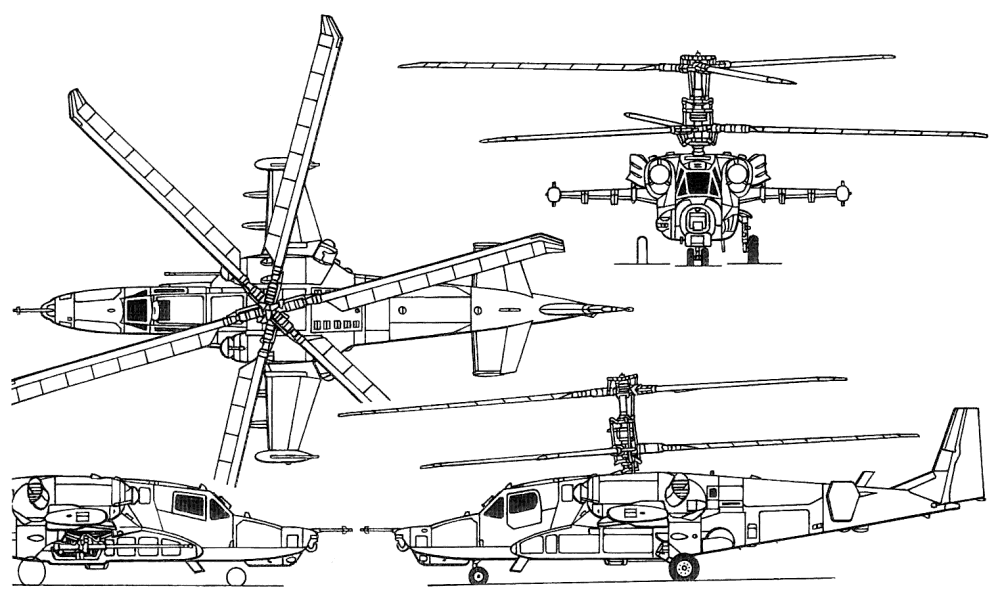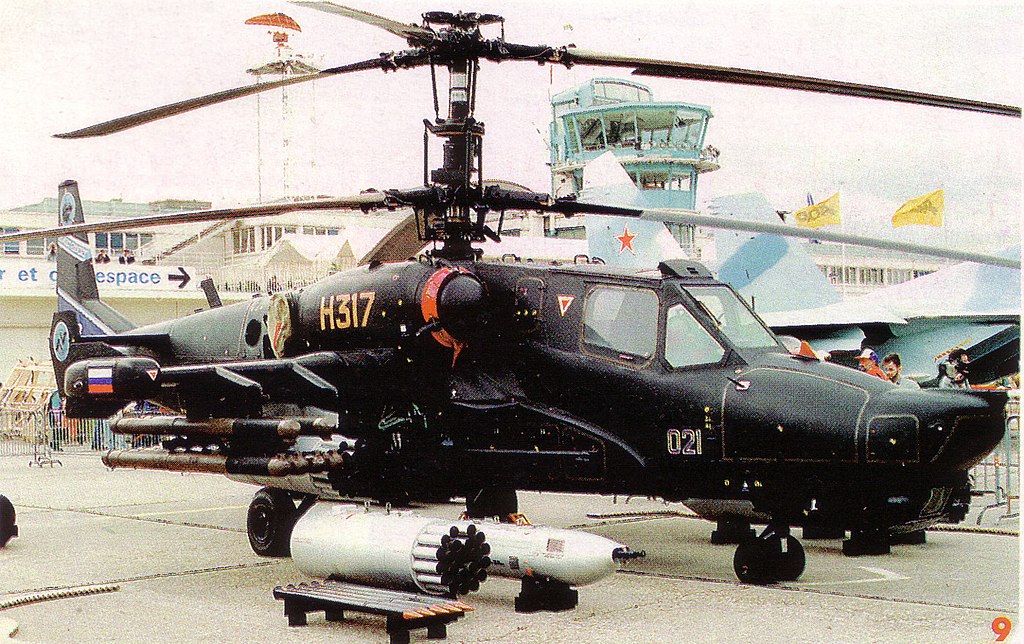The Ka-50 Black Shark helicopter (Russian: Чёрная акула; Chornaya Akula, NATO reporting name: Hokum A) is a single-seat attack helicopter for destroying armored vehicles, slow-speed air targets and manpower on the battlefield.Coaxial Ka-50 helicopter has two three-blade rotors of 14.5-m diameter each. The polymeric composite blade is attached to the hub by a torsion bar. The airframe features perfect aerodynamic outlines, mid-set stub wing, retractable three-leg landing gear and empennage of a fixed-wing aircraft type. The pilot cockpit is fully armored.
The emergency pilot escape system, comprising an ejection seat, saves the pilot within the entire flight speed and altitude range. A set of improved survivability means allows Ka-50 to attack successfully the specified targets and to survive under intensive fire counteraction.
The emergency pilot escape system, comprising an ejection seat, saves the pilot within the entire flight speed and altitude range. A set of improved survivability means allows Ka-50 to attack successfully the specified targets and to survive under intensive fire counteraction.
Development
The Ka-50 is the production version of the V-80Sh-1 prototype. Production of the attack helicopter was ordered by the Soviet Council of Ministers on 14 December 1987. Development of the helicopter was first reported in the West in 1984. The first photograph appeared in 1989. Following initial flight testing and system tests the Council ordered the first batch of helicopters in 1990. The attack helicopter was first described publicly as the "Ka-50" in March 1992 at a symposium in the United Kingdom.
The helicopter was publicly unveiled at the Mosaeroshow '92 at Zhukovskiy in August 1992. The following month, the second production example made its foreign debut at the Farnborough Airshow, where it was displayed with an image of a werewolf on its rudder—gaining the popular nickname "Werewolf". The fifth prototype gave the Ka-50 a particularly enduring designation. Painted black for its starring role in the movie Чёрная акула/Black Shark, the helicopter has been known by that nickname ever since. In November 1993, four production helicopters were flown to the Army Aviation Combat Training Centre at Torzhok to begin field trials. The president of the Russian Federation authorized the fielding of the Ka-50 with the Russian Army on 28 August 1995. The collapse of the Soviet Union led to a severe drop in defense procurement. This resulted in a mere dozen Ka-50s delivered, instead of the planned several hundred to replace the Mil Mi-24.
Kamov concluded after thorough research of helicopter combat in Afghanistan and other war zones that the typical attack mission phases of low-level approach, pop-up target acquisition and weapon launch do not simultaneously demand navigation, maneuvering and weapons operation of the pilot; and thus with well-designed support automation a single pilot can carry out the entire mission alone. During operational testing from 1985 to 1986, the workload on the pilot was found to be similar to that of a fighter-bomber pilot, and the pilot could perform both flying and navigation duties.
Like other Kamov helicopters, it features Kamov's characteristic contra-rotating co-axial rotor system, which removes the need for the entire tail rotor assembly and improves the aircraft's aerobatic qualities—it can perform loops, rolls and "the funnel" (circle-strafing), where the aircraft maintains a line-of-sight to the target while flying circles of varying altitude, elevation and airspeed around it. Using two rotors means that a smaller rotor with slower-moving rotor tips can be used, compared to a single-rotor design. Since the speed of the advancing rotor tip is a primary limitation to the maximum speed of a helicopter, this allows a faster maximum speed than helicopters such as the AH-64. The elimination of the tail rotor is a qualitative advantage, because the torque-countering tail rotor can use up to 30% of engine power. Furthermore, the vulnerable boom and rear gearbox are fairly common causes of helicopter losses in combat; the Black Shark's entire transmission presents a comparatively small target to ground fire.
The single-seat configuration was considered undesirable by NATO. The first two Ka-50 prototypes had false windows painted on them. The "windows" evidently worked, as the first western reports of the aircraft were wildly inaccurate, to the point of some analysts even concluding its primary mission was as an air superiority aircraft for hunting and killing NATO attack helicopters. For improved pilot survivability the Ka-50 is fitted with a NPP Zvezda (transl. Star) K-37-800 ejection seat, which is a rare feature for a helicopter. Before the rocket in the ejection seat deploys, the rotor blades are blown away by explosive charges in the rotor disc and the canopy is jettisoned.
The Ka-50 and its modifications have been chosen as the special forces' support helicopter, while the Mil Mi-28 has become the main army's gunship. The production of Ka-50 was recommenced in 2006. In 2009, the Russian Air Force received three units, built from incomplete airframes dating from the mid-1990s.
Structure
Fuselage built around steel torsion box beam, of 1.0m square section. Wing centre-section passes through beam. Cockpit mounted at front of beam, gearbox above and engines to sides. Carbon-based composites materials constitute 35% by weight of structure, including rotors. Approximately 350kg of armour protects pilot, engines, fuel system and ammunnion bay; canopy and windscreen panels are 55mm thick bulletproof glass.
Design Features
World's first single-seat close support helicopter. Coaxial, contrarotating and widely separated semi-rigid three-blade rotors, with swept blade tip, attached to hub by steel plates; small fuselage cross-section, with nose sensors; flat-screen cockpit, heavily armour protected by combined steel/aluminium armour and spaced aluminium plates, with rearview mirror above windscreen; small sweptback tailfin, with inset rudder and large tab; high-set tailplane on rear fuselage, with endplate auxiliary fins; retractable landing gear; mid-set unswept wings, carrying ECM pods at tips; four underwing weapon pylons; engines above wingroots; high agility for fast, low-flying, close-range attack role; partially dismantled can be air-ferried in Il-76 freighter. Much of fuselage skin formed by large hinged door panels, providing access to interior equipment from ground level.
Power plant
Two 1,633kW Klimov TV3- 117VMA turboshafts with VR-80 main reduction gearbox and two PVR-800 intermediate gearboxes, with air intake dust filters and exhaust heat suppressors. Later use of 1,838kW TV3-117VMA-SB3 turboshafts intended. Two primary fuel tanks, filled with reticulated foam, inside fuselage box beam. Total internal capacity approximately 1,800 litres. Front tank feeds port engine; rear feeds starboard and APU. Each tank protected by layers of natural rubber. Provision for four 500 litre underwing auxiliary fuel tanks. Transmission remains operable for 30 minutes after oil system failure.
Accommodation
Double-wall steel armoured cockpit, able to protect pilot from hits by 20 and 23mm gunfire over ranges as close as 100m. Interior black-painted for use with NVGs. Specially designed Zvezda K-37-800 ejection system, ostensibly for safe ejection at any altitude (actually from 100m); following explosive separation of rotor blades and opening of cockpit roof, pilot is extracted from cockpit by large rocket; alternatively, he can jettison doors and stores before rolling out of cockpit sideways. Associated equipment includes automatic radio beacon, activated during ejection, inflatable liferaft and NAZ 7M survival kit.
Systems
All systems configured for operational deployment away from base for up to 12 days without need for maintenance ground equipment; refuelling, avionics and weapon servicing performed from ground level. AI-9V APU for engine starting, and ground supply of hydraulic and electrical power, in top of centre-fuselage. Anti-icing system for engine air intakes, rotors, AoA and yaw sensors; de-icing of windscreen and canopy by liquid spray.
PrPNK Rubikon (L-041) piloting, navigation and sighting system based on five computers: four Orbita BLVM-20-751 s for combat and navigation displays and target designation, plus one BCVM-80-30201 for WCS. Incorporates PNK-800 Radian navigation system, with C-061K pitch and heading data, IK-VSP-VI-2 speed and altitude and PA-4-3 automatic position plotting subsystems. Series 3 Tester U3 flight data recorder. Ekran BITE and warning system. KKO-VK-LP oxygen system with 2 litre supply for 90 minutes. Electrical supply from two 400kW generators at 115V 400Hz three-phase AC; 500W converter; rectifiers for 27V DC supply.
Avionics
Integrated by NPO Elektro Avtomatika.
Comms: Two R800L1 and one R-868 UHF transceivers. SPU-9 intercom, P-503B headset recorder, Almaz-UP-48 voice warning system and HF com/nav; IFF ('Slap Shot').
Flight: INS; autopilot; Doppler box under tailboom; ARK-22 radio compass; A-036A radio altimeter.
Instrumentation: Conventional instruments; ILS-31 HUD; moving map display (Kronshtadt Abris on some aircraft); small IT-23MV CRT beneath HUD, with rubber hood, to display only FLIR and monochrome LLLTV imagery. Pilot has Obzor-800 helmet sight effective within ±60° azimuth and from -20 to +45° elevation; when pilot has target centred on HUD, he pushes button to lock sighting and four-channel digital autopilot into one unit. Displays compatible with OVN-1 Skosok NVGs.
Mission: To reduce pilot workload and introduce a degree of low observability, target location and designation are assigned to other aircraft; equipment behind windows in nose includes I-25IV Shkval-V daylight electro-optical search and auto-tracking system, laser marked target seeker and range-finder; FOV ±35° in azimuth +15 to -80° in elevation. FLIR turret to be added in nose for use with NVGs.
Self-defence: L150 Pastel RWR in tailcone, at rear of each wingtip EW pod and under nose; total of 512 chaff/ flare cartridges (in four UV-26 dispensers) in each wingtip pod. L-140 Otklik laser detection system; L-136 Mak IR warning.
Flying Controls
Kamov coaxial design; generally as Ka-32.
Weapons
A combination of various armaments to a maximum weapon load of 2t can be selected according to the mission, including anti-tank missiles, unguided aerial rockets of different calibres, air-to-air missiles, guns, bombs and other weapons.
The helicopter has small mid-mounted wings, fitted with four underwing suspension units and wingtip countermeasures pods. Up to 12 Vikhr supersonic anti-tank missiles can be mounted on the helicopter's two underwing external stores. The laserbeam-riding Vikhr missile is stated as having a target hit probability close to one, against a tank at a range of up to 8km, and the capability of penetrating all types of armour, including active armour up to 900mm thick.
The Ka-50 is armed with a 2A42 quick-firing 30mm gun, which has an unrestricted azimuth and elevation range mounting for use against airborne or ground targets. The gun is equipped with 460 rounds of ammunition: two types being carried, high-fragmentation and explosive incendiary rounds and armour-piercing rounds. The pilot selects the type of ammunition in flight. The weight of the ammunition is 0.39kg each round, the muzzle velocity is 980m/s and the range is up to 4km. The gun provides an angular firing accuracy of two to 4mrad.
Performance
The Ka-50 attack helicopter can climb at a rate of 16m/s. It can fly at a maximum speed of 390km/h. The maximum range and service ceiling of the helicopter are 1,180km and 5,500m respectively. It can fly at a cruise speed of 270km/h. The combat radius and disc loading of the helicopter are 460km and 30kg/m² respectively. The endurance of the helicopter is three hours. The helicopter weighs around 7,800kg and the maximum take-off weight is 10,800kg.
Technical data for Ka-50
Crew: 1, engine: 2 x TV3-117 turboshaft, rated at 1618kW, rotor diameter: 14.5m, length with rotors turning: 16.0m, take-off weight: 10800kg, empty weight: 7700kg, max speed: 310km/h, rate of climb: 10.0m/s, hovering ceiling, OGE: 4000m, range with max payload: 450km, range with max fuel: 1200km


